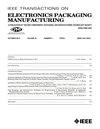Laser Micromachining of Barium Titanate $({\hbox {BaTiO}}_{3})$-Epoxy Nanocomposite-Based Flexible/Rollable Capacitors: New Approach for Making Library of Capacitors
IEEE Transactions on Electronics Packaging Manufacturing
Pub Date : 2008-04-01
DOI:10.1109/TEPM.2008.919337
引用次数: 12
Abstract
This paper discusses laser micromachining of barium titanate (BaTiO3)-polymer nanocomposite thin films. In particular, recent developments on high-capacitance, large-area, thin, flexible, embedded capacitors are highlighted. A variety of barium titanate (BaTiO3)-epoxy polymer nanocomposite-based flexible/rollable thin films ranging from 2 to 25 mum thick were processed on large-area substrates (330 mm times 470 mm, or 495 mm times 607 mm) by liquid coating processes. The electrical performance of composites was characterized by dielectric constant (Dk), capacitance, and dissipation factor (loss) measurements. Nanocomposites provided high capacitance density (10-100 nF/in2) and low loss (0.02-0.04) at 1 MHz. Scanning electron microscopy (SEM) micrographs showed uniform particle distribution in the coatings. Uniform mixing of nanoparticles in the epoxy matrix results in high dielectric (> 3 times 107 V/m) and mechanical strengths (> 3700 PSI). Reliability of the capacitor was ascertained by thermal cycling. Capacitance change was less than 5% after baking at 140degC for 4 h, and 1100 cycles from -55degC to 125degC (deep thermal cycle). A frequency-tripled Nd:YAG laser operating at a wavelength of 355 nm was used for the micromachining study. The micromachining was used to generate arrays of variable-thickness capacitors from the nanocomposites. The resultant thickness of the capacitors depends on the number of laser pulses applied.钛酸钡$({\hbox {BaTiO}}_{3})$-环氧纳米复合材料柔性/可卷曲电容器的激光微加工:制作电容器库的新方法
本文讨论了钛酸钡-聚合物纳米复合薄膜的激光微加工。特别强调了高电容、大面积、薄、柔性、嵌入式电容器的最新发展。采用液体镀膜工艺在大面积衬底(330 mm × 470 mm或495 mm × 607 mm)上制备了多种钛酸钡(BaTiO3)-环氧聚合物纳米复合材料基柔性/可卷曲薄膜,厚度从2 ~ 25 mm不等。通过介电常数(Dk)、电容和耗散系数(损耗)测量表征了复合材料的电性能。纳米复合材料在1 MHz时具有高电容密度(10-100 nF/in2)和低损耗(0.02-0.04)。扫描电镜(SEM)显示涂层中颗粒分布均匀。纳米颗粒在环氧树脂基体中的均匀混合可获得高介电强度(> 3倍107 V/m)和机械强度(> 3700 PSI)。通过热循环来确定电容器的可靠性。在140℃下烘烤4 h,从-55℃到125℃(深热循环)1100次后,电容变化小于5%。采用三倍频Nd:YAG激光器,工作波长为355nm,进行微加工研究。利用微加工技术将纳米复合材料制成变厚度电容器阵列。电容器的最终厚度取决于所施加的激光脉冲的数量。
本文章由计算机程序翻译,如有差异,请以英文原文为准。
求助全文
约1分钟内获得全文
求助全文

 求助内容:
求助内容: 应助结果提醒方式:
应助结果提醒方式:


